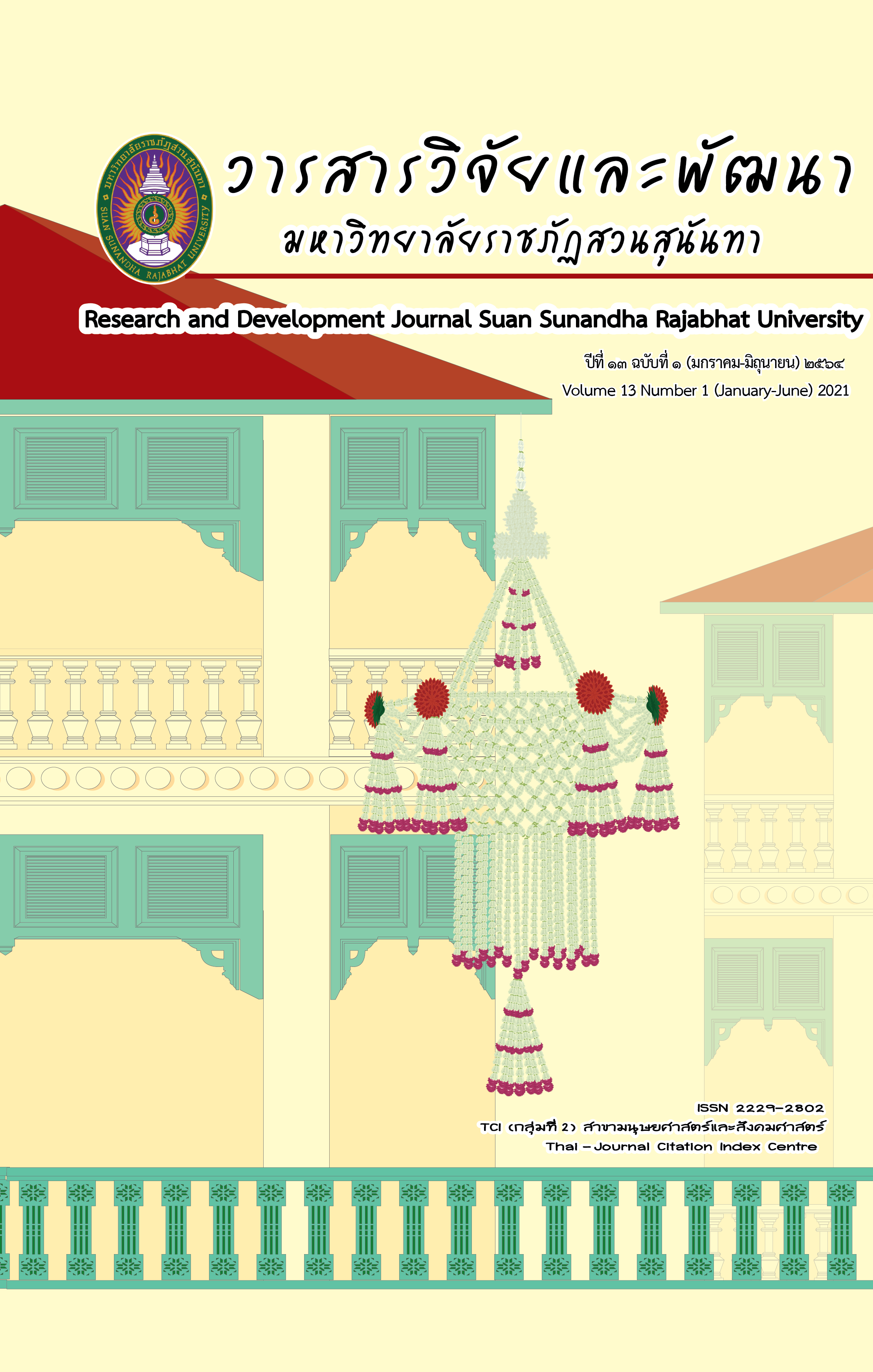ความสามารถในการแข่งขันบนฐานเศรษฐกิจดิจิทัลของวิสาหกิจชุมชน กลุ่มสินค้าท้องถิ่นในกรุงเทพมหานคร
DOI:
https://doi.org/10.53848/irdssru.v13i1.246602คำสำคัญ:
ความสามารถในการแข่งขัน, ฐานเศรษฐกิจดิจิทัล, วิสาหกิจชุมชน, สินค้าท้องถิ่นบทคัดย่อ
การวิจัยนี้มีวัตถุประสงค์เพื่อวิเคราะห์ปัจจัยภายในและภายนอกของวิสาหกิจชุมชน และพัฒนากลยุทธ์ความสามารถในการแข่งขันบนฐานเศรษฐกิจดิจิทัลของวิสาหกิจชุมชน กลุ่มสินค้าท้องถิ่น ในกรุงเทพมหานคร โดยใช้วิธีการวิจัยเชิงคุณภาพ เก็บข้อมูลโดยการสัมภาษณ์เชิงลึกจากผู้ให้ข้อมูลหลัก คือผู้ประกอบการในบัญชีรายชื่อผู้ที่ได้รับการรับรองคุณภาพผลิตภัณฑ์ชุมชน ในกรุงเทพมหานคร จำนวน 12 ราย และวิเคราะห์ข้อมูลด้วยแบบจำลอง PRIMO-F Analysis, PEST Analysis, SWOT Analysis และวางแผนกลยุทธ์ด้วยเทคนิค TOWS Matrix
ผลการวิจัย พบว่าปัจจัยภายในควรกำหนดกลยุทธ์เชิงรุก ได้แก่ 1) พัฒนาตราสินค้าให้เป็นที่รู้จักแก่ผู้บริโภค 2) เพิ่มช่องทางการจัดจำหน่ายผ่านทางออนไลน์ 3) ขยายตลาดไปยังตลาดนอกชุมชนผ่านสื่อออนไลน์ ส่วนกลยุทธ์เชิงป้องกัน ได้แก่ 1) พัฒนาหน้าร้านที่มีเอกลักษณ์เฉพาะ 2) พัฒนาผลิตภัณฑ์ใหม่ที่แตกต่างจากคู่แข่ง 3) ศึกษาพฤติกรรมของผู้บริโภคในยุคดิจิทัล 4) สร้างฐานข้อมูลลูกค้าและพัฒนาความสัมพันธ์ที่ดีกับลูกค้าเพื่อสร้างความภักดีในตราสินค้า นอกจากนี้ ปัจจัยสภาพแวดล้อมภายนอกควรกำหนดกลยุทธ์เชิงพัฒนา ได้แก่ 1) นำนวัตกรรมใหม่มาใช้กับการผลิตและการจัดการ 2) ร่วมกับสถาบันการศึกษาหรือหน่วยงานภาครัฐในการพัฒนานวัตกรรมผลิตภัณฑ์ 3) สร้างเครือข่ายร่วมกับสถานศึกษาหรือหน่วยงานภาครัฐพัฒนาความรู้ด้านการบริหารและเทคโนโลยีดิจิทัล 4) หน่วยงานภาครัฐให้การสนับสนุนการประกอบธุรกิจบนฐานดิจิทัล ส่วนกลยุทธ์เชิงรับ ได้แก่ 1) พัฒนาความรู้ในการประกอบธุรกิจในยุคดิจิทัล 2) พัฒนาความพร้อมในการใช้เทคโนโลยีดิจิทัล 3) พัฒนาระบบการบริหารบนพื้นฐานดิจิทัลที่มีประสิทธิภาพ ผลการวิจัยนี้สามารถนำไปใช้ประโยชน์ในเชิงเศรษฐกิจและสังคมดิจิทัล และเป็นแบบอย่างในการวางรากฐานการพัฒนาชุมชนและประเทศต่อไป
เอกสารอ้างอิง
Aslan, I., Çınar, O., & Kumpikaite, V. (2012). Creating strategies from tows matrix for strategic sustainable development of Kipas Group. Journal of Business Economics and Management, 13(1), 95-110.
Bunpis, L., & Haron, M. S. (2014). The influence of content marketing on customer brand engagement towards online herbal cosmetic store in Thailand.
Biagi, F., & Falk, M. (2017). The impact of ICT and e-commerce activities on employment in Europe. Ratio Working Papers, 285.
Bureau of Local Knowledge Promotion and Community Enterprise, Community Development Department. (2020). One Tambon One Product (OTOP) project information. Retrieved June 15, 2020, from https://cep.cdd.go.th/เกี่ยวกับ-OTOP/ข้อมูลทั่วไปOTOP.
Electronic Transactions Development Agency. (2020). Report of the 2020 internet user behavior survey: Thailand internet user behavior 2020. Retrieved June 15, 2020, from https://www.etda.or.th/getattachment/c5835c06-e238-4cda-9816-814df31caca5/IUB_2020_Web.pdf.aspx.
Hameed, W. U., Basheer, M. F., Iqbal, J., Anwar, A., & Ahmad, H. K. (2018). Determinants of Firm’s open innovation performance and the role of R & D department: an empirical evidence from Malaysian SME’s. Journal of Global Entrepreneurship Research, 8(1), 29.
Handayani, P. W., & Arifin, Z. (2017). Factors affecting purchase intention in tourism e-marketplace. Paper presented at the 2017 International Conference on Research and Innovation in Information Systems (ICRIIS).
Kritsana Darareung. (2016). The competitive strategy development of OTOP product: Konean shredded pork at Ongkradone Subdistrict, Muang District, Nakhonsawan. Modern Management Journal, 14(2), 67-78.
Misra, R., Mahajan, R., & Singh, N. (2020). Understanding Factors Affecting Receptivity Towards Adopting Electronic Marketplace: A Merchant Perspective. e-Service Journal. Vol. 12, No. 1 (Fall 2020), pp. 1-40.
Office of Small and Medium Enterprises Promotion. (2020). Executive summary: small and medium enterprises situation report 2020. Retrieved June 15, 2020, from https://www.sme.go.th/upload/mod_download/download20200824164414.pdf.
Prasad, S., Totala, N. K. and Gupta, I. C. (2014). Social media and customer purchase decision. American International Journal of Research in Humanities, Arts and Social Sciences. 8:166-171.
Pickton, D. W., & Wright, S. (1997). SWOT analysis-Its role in strategic and management development in SMEs. In Small Business and Enterprise Development Conference (pp.1-10). Sheffield, UK: Sheffield University.
Sunisa Klinkhachon. (2015). Small and micro community enterprise potential development herbal products Ban Khaonanai Tonyuan Sub-District Amphoe Phanom Suratthani Province. Veridian E-Journal, Silpakorn University, 8(2), 2643-2655.
Suwanmaneepong, S., Fakkhong, S., & Kullachai, P. (2018). SWOT analysis and marketing strategies development of agricultural products for community group in Nong Chok, Bangkok, Thailand. International Journal of Agricultural Technology. Vol. 14(7): 2027-2040.
Tanyamai Chiarakul. (2014). The problems and the adaptation of OTOP to AEC. Executive Journal, 34(1), 177-191.
Thai Industrial Standards Institute. (2021). Quality community products of people certificate lists in Bangkok. Retrieved June 15, 2020, from http://tcps.tisi.go.th/public/certificatelist.aspx?province=10&provincename=%Bangkok.
Thanrawee Thornsiripunnarote, Kritsada Tunpow and Kanyamon Kanchanathaveekul. (2019). Marketing strategy to success of spa enterpreneur through digital channel in Bangkok digital channel in metropolitan region. Journal of the Association of Researchers: Humanities and Social Sciences, 24(1), 72-84.
Thichakorn Kasornbua and Chanoon Pinsam. (2018). Entrepreneur development strategies for One Tambon One Product (OTOP) from Benjaburapra group to Thai-Cambodia border trade (Aranyprathet) by SWOT analysis. RMUTT Global Business and Economics Review, 13(2), 51-65.
Weihrich, H. (1982). The TOWS matrix-A tool for situational analysis. Long Range Planning, 15(2), 54-66.
ดาวน์โหลด
เผยแพร่แล้ว
รูปแบบการอ้างอิง
ฉบับ
ประเภทบทความ
สัญญาอนุญาต
ลิขสิทธิ์ (c) 2021 มหาวิทยาลัยราชภัฏสวนสุนันทา

อนุญาตภายใต้เงื่อนไข Creative Commons Attribution-NonCommercial-NoDerivatives 4.0 International License.
บทความที่ได้รับการตีพิมพ์เป็นลิขสิทธิ์ของ สถาบันวิจัยและพัฒนา มหาวิทยาลัยราชภัฎสวนสุนันทา
ข้อความที่ปรากฏในบทความแต่ละเรื่องในวารสารวิชาการเล่มนี้เป็นความคิดเห็นส่วนตัวของผู้เขียนแต่ละท่านไม่เกี่ยวข้องกับมหาวิทยาลัยราชภัฎสวนสุนันทา และคณาจารย์ท่านอื่นๆในมหาวิทยาลัยฯ แต่อย่างใด ความรับผิดชอบองค์ประกอบทั้งหมดของบทความแต่ละเรื่องเป็นของผู้เขียนแต่ละท่าน หากมีความผิดพลาดใดๆ ผู้เขียนแต่ละท่านจะรับผิดชอบบทความของตนเองแต่ผู้เดียว





